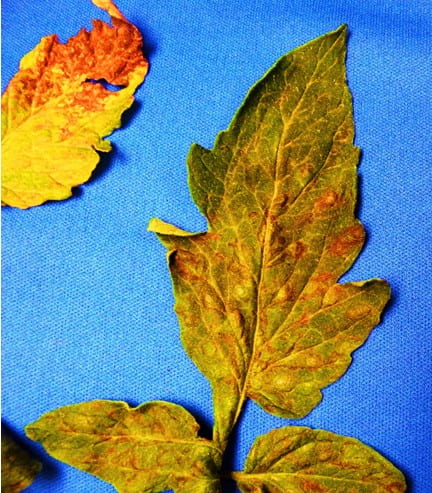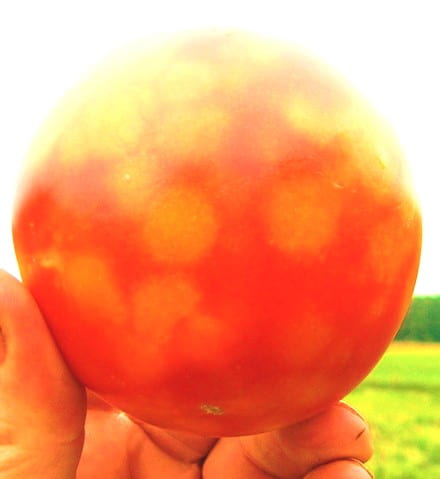Tomato Spotted Wilt Virus in Tomatoes
By Jerry Brust, UME
A few high tunnels and even a couple of tomato fields have been found with tomato spotted wilt virus (TSWV) in Maryland. The high tunnel finds were not too surprising
but the fields were, as we usually do not see field infections until much later into the season. TSWV has also been found in greenhouse and field production of cut flowers. So it appears this virus is more common this year than it usually is, most probably due to greater thrips populations being present in our greenhouse production areas.

Tomato spotted wilt virus (TSWV) is an obligate parasite, i.e., it must have a living host and must be moved from one plant to another by thrips or through cuttings or possibly seed. This disease can affect tomato and other Solanaceae crops as well as lettuce, beans and cucumber. TSWV may occur in the field but tends to affect greenhouse and high tunnel crops more severely. TSWV is transmitted most efficiently by Western flower thrips (WFT) (Frankliniella occidentalis), and less so by Onion thrips (Thrips tabaci), Tobacco thrips (Frankliniella fusca) and several other thrips species. It is not transmitted by Eastern flower thrips (Frankliniella tritici).
Western flower thrips completes its life cycle in about 10-18 days. Eggs are laid in the leaf or tomato fruit. When WFT oviposit into tomato fruit they often cause a deeper dimple than other thrips species and very often the dimple is surrounded by a white halo of tomato tissue. Larvae hatch in about three days and immediately begin to feed and in so doing pick up the virus. After four days, they pupate in the soil, and in a little over three days, the pupae become adults. Only immature thrips can acquire the virus, which they can acquire within 15 minutes of feeding, but adults are just about the only stage able to transmit the virus. Adults can transmit the virus for weeks. It may take 2 – 4 weeks from when the adult thrips first feeds on a plant until initial symptoms are observed. Because of this TSWV appears to worsen in plantings over time.
TSWV infected leaves can show small, dark-brown spots or streaks (fig. 1) on stems and leaf petioles. Growing tips are usually affected with systemic necrosis and potentially stunted growth. Tomato fruit will have mottled, light green or yellow spots or rings usually with raised centers (fig 2).

The host range for TSWV is one of the largest of any plant virus – hundreds of plant species, including vegetables, ornamentals and weed species, are susceptible. Weed hosts act as important virus reservoirs for TSWV and can survive in and around greenhouses, high tunnels or fields. Some of these weeds include prickly lettuce, chickweed, spiny amaranth, lambsquarters, black nightshade, shepherd’s purse, galinsoga and burdock. These weeds as well as adult thrips need to be controlled in the greenhouse where vegetable transplants are being produced. Because thrips are commonly found in bedding plants or other flower production areas vegetable transplants should never be grown in the same GH as these ornamentals.
